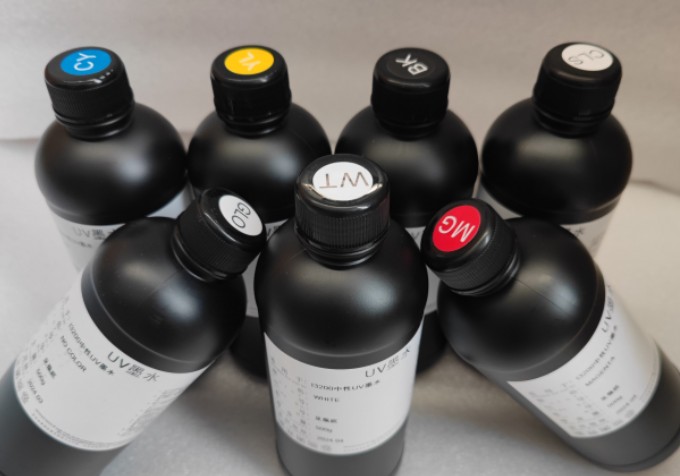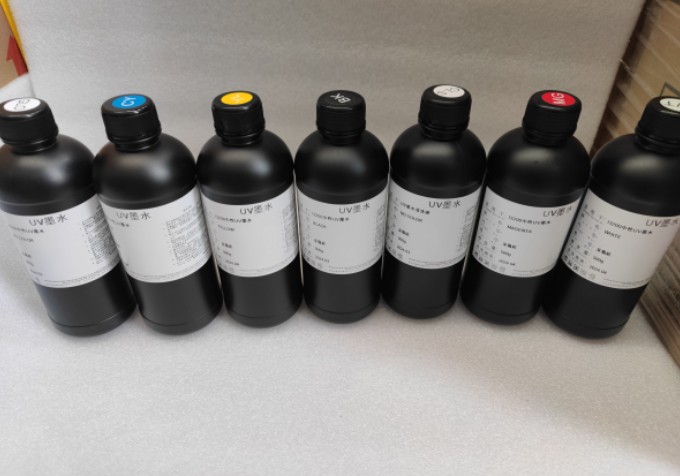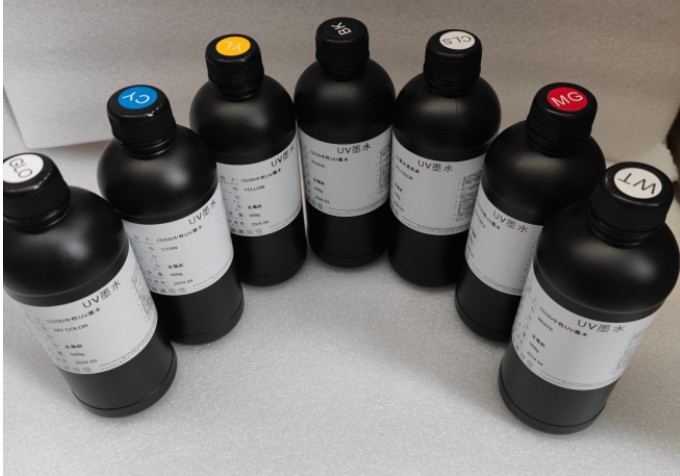13
Oct
We all know that UV ink has great advantages over other inks in terms of environmental protection, adaptability, drying speed... UV ink is a kind of ink that does not require solvents, dries quickly, has good gloss, bright colors, is water-resistant, solvent-resistant, and has good abrasion resistance. At present, UV ink has become a relatively mature ink technology, and its pollutant emissions are almost zero. This is also a factor why UV printers use purple light for curing. However, UV ink also has a bad side. Because of the characteristics of UV ink, UV ink is not easy to store.

Definition of UV ink
UV (ultraviolet light curing) ink refers to an ink that uses ultraviolet light of different wavelengths and energies to polymerize monomers in the ink binder into polymers under ultraviolet irradiation to form a film and dry the ink. UV inks are also inks. As inks, they must have bright colors (except in special circumstances), good printability, and appropriate curing and drying rates. At the same time, it has good adhesion, and has properties such as wear resistance, corrosion resistance, and weather resistance.
Comparison between UV ink and traditional thermosetting luminescent ink
The composition of UV ink is very different from traditional ink. The film formation of UV ink is a chemical reaction. Monomers and polymers undergo polymerization reactions under the action of initiators. However, the film formation of traditional ink is a physical effect. The resin has already been polymerized. The solvent dissolves the solid polymer into a liquid polymer and prints it on the substrate. Then the solvent evaporates or is absorbed, causing the liquid polymer to return to its original solid state.
The composition and advantages of UV ink
The structure of UV ink includes resin and monomer instead of solvents, additives and photoinitiators. The resin in UV ink is very different from the resin in solvent volatile ink. It is reactive and can react with certain products in other chemical reactions. In UV ink, it can react with monomers. Monomers are low molecular weight chemicals that can replace solvents to some extent and reduce viscosity to make them suitable for printing. But in addition to acting as a solvent or diluent, it also has a very important role - participating in chemical reactions. Every component in UV ink can react chemically, and because it is 100% cured, all components will become solid through chemical reactions.
Advantages of UV ink in printability
Compared with solvent-based inks, UV inks have greatly improved their printability and printing quality. Since UV ink is 100% solid and has no volatile solvents, the viscosity of the ink will not change as environmental conditions change. In the past, printers had to complete a long printing cycle, especially when printing fine patterns, and always encountered the problem of viscosity changes. When printing, the ink was scraped back and forth, and the solvent evaporated, causing the viscosity to change. Every once in a while, The thickness of the ink layer will be different. As for UV ink, the viscosity of the ink will not change after a day of work, and the quality of the printed products will be exactly the same. In terms of cleaning, UV ink will be put into the curing equipment for curing immediately after printing, so the printed product will not come into contact with many impurities and the product can be kept clean. Solvent-based ink takes a long time to dry after printing. When there is a lot of dust in the environment, it will pollute the product. When making luminous signs, it is often necessary to print thicker and require multiple printings to meet the thickness requirements. At this time, printing with traditional inks requires a pass through the drying tunnel after each printing, which requires a lot of time and energy. When printing with UV curable ink, there is no need to dry it in a drying tunnel. It can be cured immediately after each printing and can be used for the next step, which greatly saves time and energy.

In general, UV ink has the following advantages:
1) It does not contain volatile organic solvents, has little pollution, does not harm human health, and has a solid content of 100%. There is no problem of inconsistent printing ink film thickness due to the volatilization of solvents;
2) The ink does not block the screen, which is conducive to the printing of fine products;
3) During printing, there is no need to worry about solvent damage to the substrate, the ink quality is stable, the dry ink film has good gloss, and the ink film is wear-resistant, water-resistant, oil-resistant, and Good solvent properties;
4) The ink dries instantly, which can organize fast printing production lines and greatly improve printing efficiency;
5) Save ink when printing, solvent-based ink can print about 50 meters per kilogram, while UV ink can print 70 meters per kilogram.
UV ink storage utensil requirements:
The bottle storing UV ink must be black! Tight bottle! The same goes for bottle caps. Do not use fragile materials such as glass, and keep the gap between ink bottles at 3-5 cm to avoid back-and-forth collisions.
Now, TEXTEK will tell you what issues you should pay attention to during the storage and management of UV ink:
1. There are certain requirements for the storage environment of UV ink. The temperature is best controlled at 18~25℃, and the humidity is best controlled at 55%~65%. The hygienic condition of the environment is also very important. If there are a large number of dust particles in the air, they may fall into the UV ink tank or be adsorbed on the surface of the label material. When the ink is opened, it will fall into the ink, thus affecting the printing quality. It is best to store UV ink in a sealed container to avoid dust.
2. When storing UV ink, try to keep it away from fire and heat sources to prevent accidents.
3. It is best to maintain a constant temperature in the ink warehouse, and the temperature difference between the ink warehouse and the printing workshop should not be too great. If the temperature difference between the two is large, the ink should be placed in the printing workshop in advance, which will not only stabilize the performance of the ink, but also ensure high production efficiency.
4. Avoid placing it in a dry environment. The climate is relatively cold in winter. Avoid storing the ink outdoors to prevent the ink from gelling at low temperatures. If the ink gels, it can be transferred to a warehouse with a higher temperature, or placed in hot water to restore the insoluble matter to its original state.
5. The principle of "first in, first out" should also be followed in the storage and management of ink, that is, the ink purchased first is used first to prevent the ink from being affected by its use due to long storage time.
6. The remaining ink after printing must be sealed and stored in a dark place and can be reused in future production. It must be filtered with a filter before reuse. On the one hand, it must be thoroughly stirred before it can be mixed with new ink. On the other hand, it can effectively prevent the clogging of the UV printer nozzle.
7. UV ink also has a certain shelf life. If stored for too long, various components in the ink formula may separate and precipitate. Therefore, uv ink should not be stored for a long time, and the general storage period is about 1 year. Otherwise, it may affect the printing quality and even cause printing failures.

The prospect of UV ink
my country is very rich in rare earth resources. There are many varieties of rare earth luminescent materials and they are widely used. Rare earth luminescent materials can be combined with inks to produce photoluminescent safety signs through screen printing. They can be made of PVC rigid low-foaming polyvinyl chloride sheets or flame-retardant ABS materials according to the location, environment and customer requirements. Fire sign. At present, the development of photoluminescent safety signs in our country has broad prospects, and its social and economic benefits are immeasurable. In the past, thermoset luminescent inks were mostly used to produce luminous safety signs, which had shortcomings such as large solvent volatilization, complex processes, time-consuming, and high energy consumption. Therefore, the development of an ink with a simple process, clean and environmentally friendly, and energy-saving has become the focus of attention.
Combining UV curing ink with rare earth luminescent materials to prepare UV luminescent ink can make the printing process clean and environmentally friendly, with low energy consumption and suitable for continuous production. The UV cured product has excellent performance in terms of gloss, wear resistance, hardness, solvent resistance, In terms of aesthetics and other aspects, it has excellent qualities that are unmatched by other curing methods. UV luminescent ink is a new type of ink suitable for modern industrial production.
TEXTEK's business covers many countries around the world, including emerging markets and mature markets. We have a complete sales system and are committed to using our professional knowledge and first-class service to help customers improve their digital printing business.
.jpg)
